ANATOMY OF EXTERNAL NOSE
The nose is the first part of the upper respiratory tract and is responsible for warming, humidifying and filtering of inspired air. It contains the peripheral organ of smell. The external nose opens anteriorly on to the face through the nostrils or nares. It is pyramidal projection in the mid face with its root up and the base directed downwards. Nasal pyramid consists of osteocartilaginous framework covered by muscles and skin.
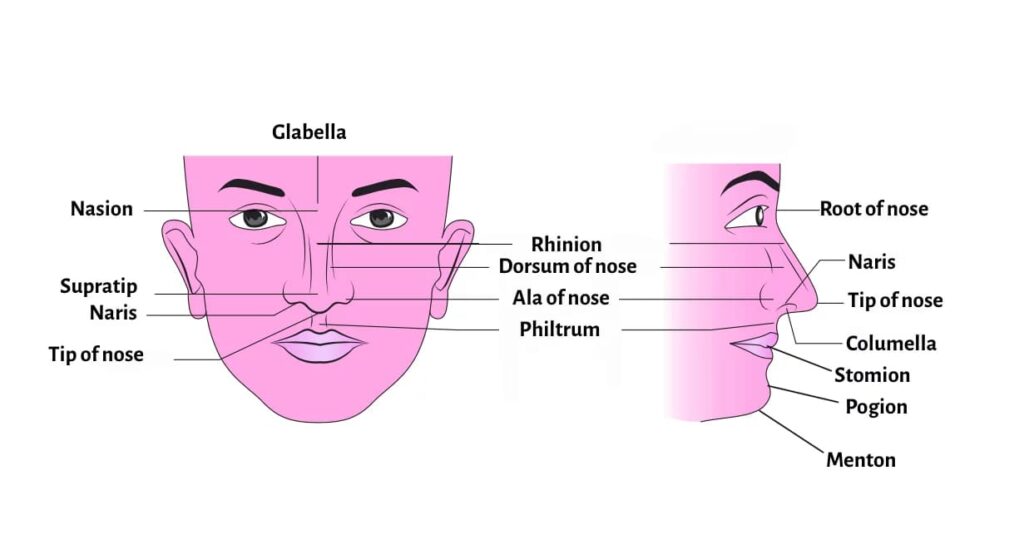
It presents the following features:
- Tip of the nose. It is the lower free end of nose
- Supratip. It is present just above the tip of the nose.
- Root or bridge. It is the uppermost narrow part of nose.
- Nasion. It is the junction between frontal bones and nasal bones.
- Rhinion. It is the junction between nasal bones and cartilages.
- Dorsum.
- Nostrils or nares.
- Ala. It is formed by alar cartilages.
Osteocartilaginous framework
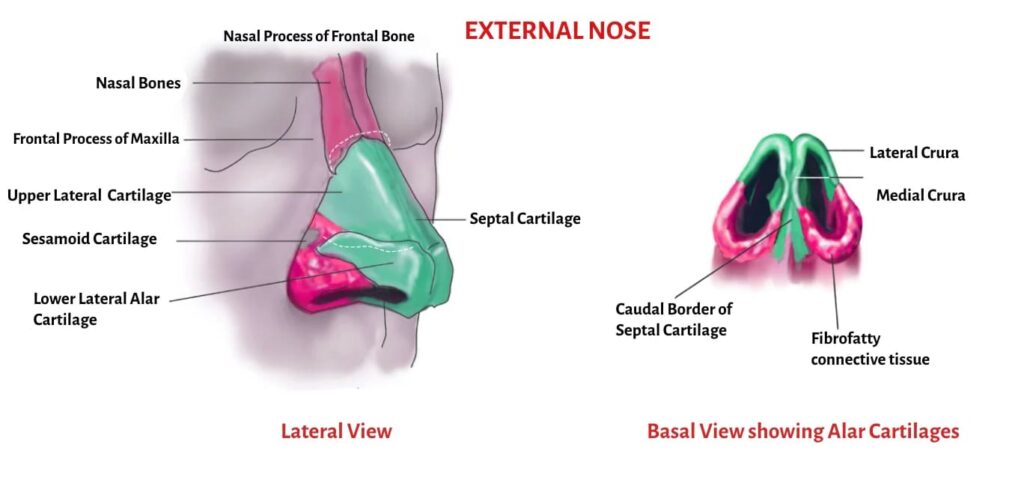
Bony Part (Nasal bones)
Upper one-third of the external nose is bony while lower two-thirds are cartilaginous. The bony part consists of two small rectangular nasal bones which meet in the midline. It forms the bridge of the nose.
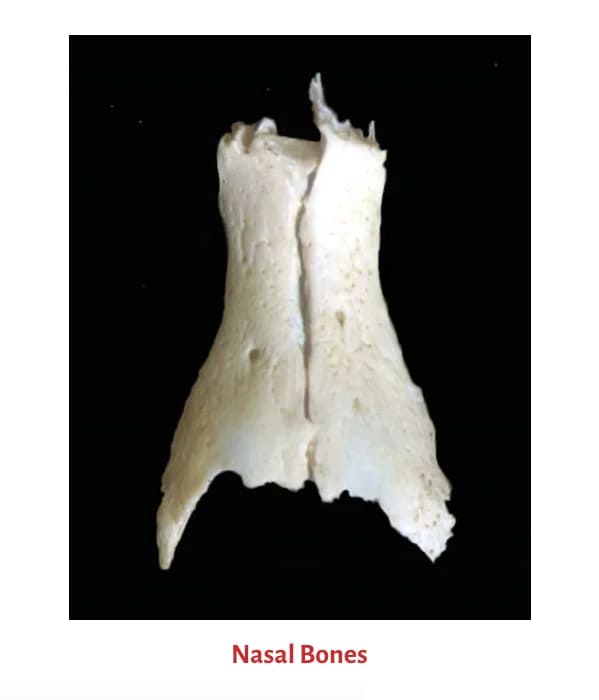
Boundaries of nasal bones:
- The superior border articulates with the nasal process of the frontal bones.
- The inferior border is related to the upper lateral cartilage.
- The lateral border articulates with the frontal process of the maxilla.
- The medial border articulates with the opposite nasal bone and forms a small part of the septum of the nose.
Cartilaginous Part
The nasal cartilages are hyaline cartilages which are attached to the bones to form the skeletal framework of the external nose.
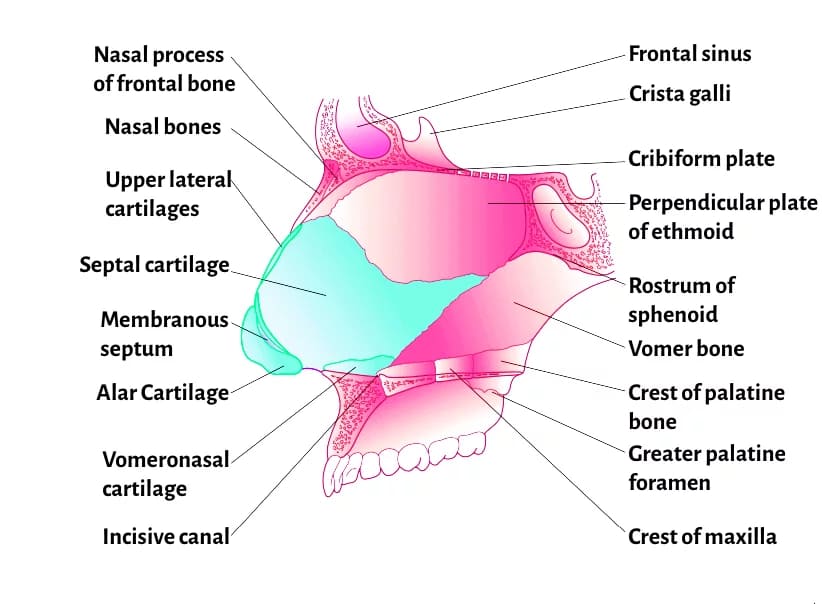
It consists of:
- Upper lateral cartilages. They are trapezoid shaped and extend from the under-surface of the nasal bones (rhinion) above, to the lower lateral cartilages and alar cartilages below. They fuse with each other and attach with the upper border of the midline septal cartilage. The lower free edge of upper lateral cartilage is seen intranasally as limen vestibule, nasal valve or limen nasi on each side.
- Lower lateral cartilages (alar cartilages). Each alar cartilage is U-shaped. It has a lateral crus which forms the ala and a medial crus which runs in the columella and form the natural arch of the nasal ala. Lateral crus overlaps lower edge of upper lateral cartilage on each side.
- Lesser alar (or sesamoid) cartilages. Two or more innumber. They lie above and lateral to alar cartilages. The various cartilages are connected with one anoth-er and with the adjoining bones by perichondrium and periosteum. Most of the free margin of nostril is formed of fibrofatty tissue and not the alar cartilage.
- Septal cartilage. Its anterosuperior border runs fromunder the nasal bones to the nasal tip. It supports the dorsum of the cartilaginous part of the nose. In septal abscess or after excessive removal of septal cartilage as in submucosal resection (SMR) operation, support of nasal dorsum is lost and a supratip depression results.
NASAL MUSCLES
Osteocartilaginous framework of nose is covered by muscles which function to elevate, depress, compress, or dilate the nostrils and nasal tip.
- Nasal elevator muscles – Procerus, Levator labii-superioris alaeque nasi, Anomalous nasi muscles.
- Nasal depressors muscles – Alar nasalis and Depressor septi nasi.
- Compressor muscles – Transverse nasalis.
- Dilator muscles – Dilator naris anterior.
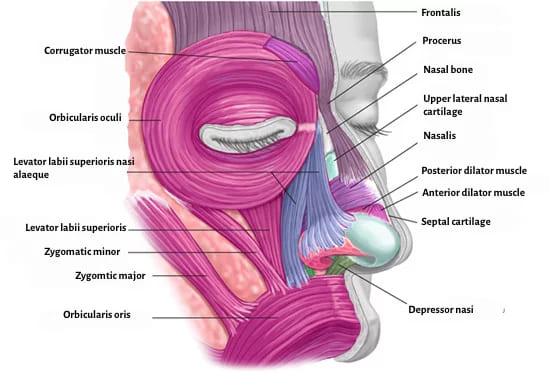
NASAL SKIN
The skin over the nasal bones and upper lateral cartilages is thin and loosely adherent to underlying framework. The skin over the nasal tip and alar cartilages is becomes thicker and more adherent, and contains numerous sebaceous glands. It is the hypertrophy of these sebaceous glands which gives rise to a lobulated tumour called rhinophyma.
VESTIBULE OF NOSE
It is the most anterior and inferior aspect of nasal cavity. It is also the entry point from the external nose into the nasal cavity. It is lined by skin and contains sebaceous glands, sweat glands and coarse hairs called vibrissae. Vibrissae filters the airborne particles during inspiration. Caudal border of the lower lateral cartilage on lateral wall demarcates limen nasi (also called nasal valve), which is the upper limit of vestibule. Incision is given in limen nasi during external approach rhinoplasty.
- Nasal valve. It is bounded laterally by the lower border of upper lateral cartilage and fibrofatty tissue and anterior end of inferior turbinate, medially by the cartilaginous nasal septum, and caudally by the floor of pyriform aperture. The angle between the nasal septum and lower border of upper lateral cartilage is nearly 30°.
- Nasal valve area. It is the cross-sectional area boundedby the structures forming the valve. It is the least cross-sectional area of nose and regulates airflow and resist-ance on inspiration.
BLOOD SUPPLY OF EXTERNAL NOSE
Arterial supply – Branches of both external and internal carotid artery supplies the external nose.
- Nasal dorsum – Lateral nasal branch of the angular artery and external nasal branch of the anterior ethmoid artery.
- Nasal side wall – External nasal branch of the infraorbital artery.
- Alar region – Angular and superior labial arteries.
- Columella – Columellar branch of superior labial artery
Venous drainage – into facial vein and ophthalmic vein.
NERVE SUPPLY OF EXTERNAL NOSE
It is clinically important for the surgeon while giving nerve block for procedures such as rhinoplasty or closed reduction of nasal fractures.
- Supra and infratrochlear branches of the ophthalmic nerve – Root of the nose, upper part of nasal bridge and upper part of the lateral wall of the nose.
- Infraorbital branch of the maxillary nerve – Lower part of the lateral wall of the nose.
- Anterior ethmoid nerve – Lower part of nasal bridge and nasal tip.
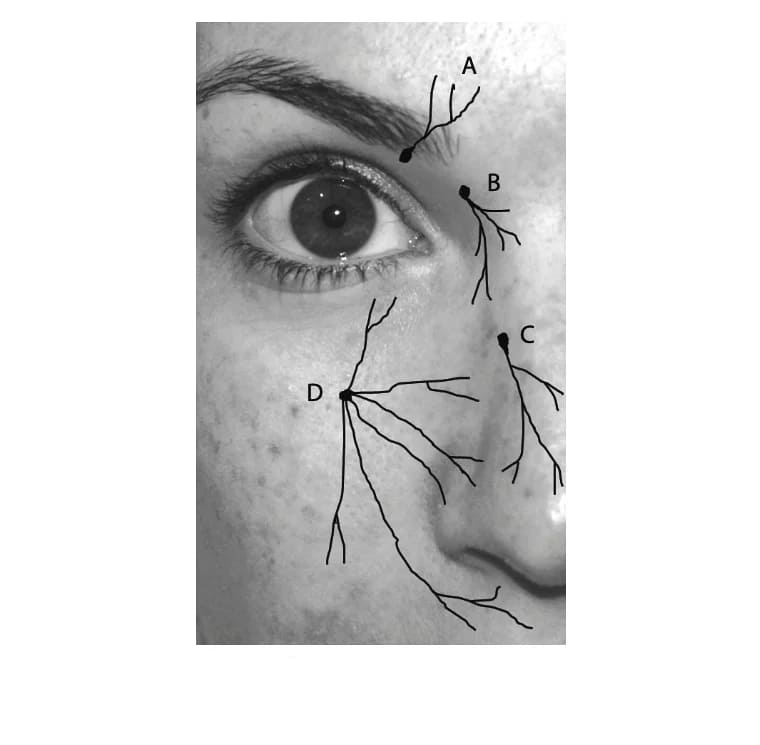
External nose nerve supply. (A) supratrochlear nerve (B) infratrochlear nerve (C) anterior ethmoid nerve (D) infraorbital nerve.
LYMPHATIC DRAINAGE
It drains into submandibular, submental and facial nodes.
———— End of the chapter ————
Author:

Dr. Rahul Kumar Bagla
MS & Fellow Rhinoplasty & Facial Plastic Surgery.
Associate Professor & Head
GIMS, Greater Noida, India
msrahulbagla@gmail.com
Please read. Glomus Tumour. https://www.entlecture.com/glomus-tumour/
Follow our Facebook page: https://www.facebook.com/Dr.Rahul.Bagla.UCMS
Join our Facebook group: https://www.facebook.com/groups/628414274439500
